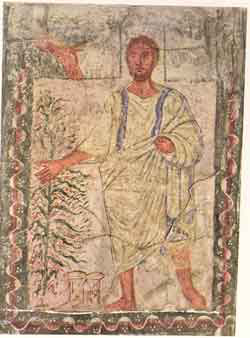For additional images on this subject see TALI Visual Midrash
The splitting of the Red Sea and the Children of Israel’s rescue from Egypt in Exodus 13 - 16 is the climax and conclusion of the long episode of the Exodus from Egypt that starts in Exodus 4. The Children of Israel’s escape from the Egyptians is described as a double miracle – God “split” the sea to enable the Children of Israel to cross it and then brought the waters down to finish off the Egyptians. The Children of Israel are commanded to observe this double miracle in order to testify to future generations about the Divine salvation they were privileged to experience. They respond to the event by singing the Song of the Sea, which expresses the greatness of the miracle, the survivors’ joy and the praise for God in their hearts.
Jewish, Christian and Muslim artists throughout history dealt with the splitting of the Red Sea. The great interest in this episode surely stems from its inherent drama and visual elements. But as we will see below, from a review of a small sampling, artists interpret the event very differently.
The Sons and Daughters of Israel as Eye-Witnesses
The painting below is by Laura James, a contemporary African-American artist, who employs a traditional Ethiopian style in her paintings.
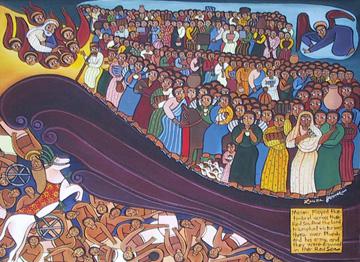
A large crowd stands on the shore of the Red Sea, in a line that undulates in three waves, starting from the angel in the upper right corner. Standing out in this crowd – because of their head coverings – are Miriam on the right in a white dress and Moses, who is holding a staff, on the left. On Moses’ left, God floats in the air surrounded by angels. Apart from Moses, all the figures are women.
In this painting, everything is in motion. In addition to the undulating waves of people, the individuals are also moving; for the most part they are not standing straight, but rather with their hips on an angle and swaying – in other words, they are dancing! The role of women in this event and the dancing are stressed by the caption on the right side, which refers specifically to Miriam and the victory song she leads.
Another element in this painting is the Children of Israel’s open eyes, highlighted by the closed eyes of Pharaoh’s army drowning in the sea. This emphasis on seeing already appears in the description of the splitting of the Red Sea in the book of Exodus.
When Pharaoh drew near, the Children of Israel lifted up their
eyes and behold Egypt marched after them and they were very
much afraid and the Children of Israel cried out to the Lord.
Moses said to the people Fear not, stand still and see the salvation
of the Lord which He will show you today; for as you have seen
Egypt this day, you shall not see them again any more for ever.
Exodus 14:10, 13
In short, the Children of Israel are commanded to watch the victory over the Egyptian army, so that they can serve as witnesses for future generations as, the Passover Haggadah says:
In every generation each person has an obligation to regard
himself as if he had gone forth from Egypt. As it is written,
“And you shall tell your son in that day, saying, Because of
that which the Lord did for me when I came forth out of
Egypt.” It was not only our fathers that the Holy One Blessed
be He redeemed, but us too He redeemed with them; as it is
said: “And he brought us out from there, so that he might
bring us in, to give us the land which he swore unto your
fathers.”
Another interpretation of the splitting of the Red Sea, which also highlights the joyousness of the event, is a painting by Israeli artist Nahum Gutman that appears in an illustrated Passover Haggadah from the 1930's.
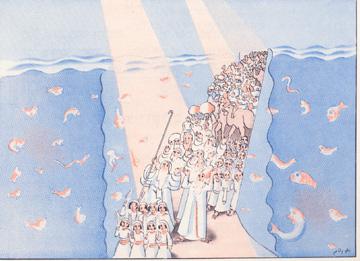
Here too, the Children of Israel burst into song, but they are still marching in the sea led by Moses and Aaron, and the crowd includes men, women and children. There is a very festive atmosphere and light descends from the heavens. This painting is reminiscent of parades and ceremonies that were held in Israel even prior to the establishment of the state – such as the Tel Aviv ‘Adeloyada’ parade on Purim and the kibbutz celebrations of the Shavuot festival. Alternately, it is possible to see the Children of Israel in the Red Sea as the prototypes of immigrants to Palestine during the days of the British mandate. In both cases, Gutman presents the biblical event using models familiar to the emerging Jewish society in Palestine and their fervent identification with the history of the People of Israel.
The next picture also focuses on the Children of Israel and was drawn by 19th century American folk artist Erastus Salisbury Field.
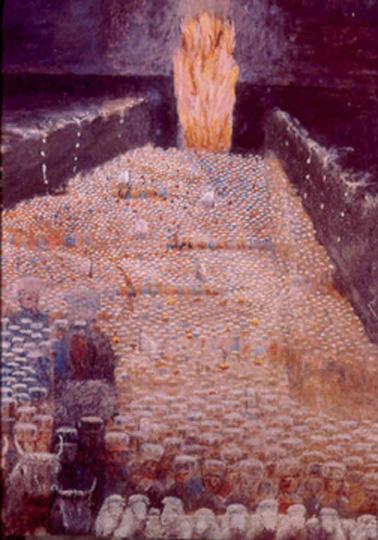
We see here a huge crowd – whose details are blurred even in the front rows – just beginning to emerge from the sea, which stands like a wall to the right and left of them. Behind them is the soaring pillar of fire that separates between the crowd from the Egyptians.
In addition to his work as an artist, Field was also one of the first photographers in America and it seems that his style of drawing was influenced by the constraints of photography in his day; the subjects were required to stand still for long periods because of the camera’s slowness. Therefore, in clear contrast to James’ painting, which depicts movement, Field’s painting seems static.
And in contrast to James’ painting, there are no faces visible at all in this painting. In fact, we see in the first row sheep and bulls and it is impossible to even distinguish between the animals and the people. The subject of this drawing is a collective image – the People of Israel.
In this painting, the role of the People of Israel is not to attest to the splitting of the Red Sea – they are the evidence of the splitting of the Red Sea. The entire community faces us, the viewers, as if approaching us in an effort to include us in the evidence. This is a sort of class picture that documents a successful finish.
Moses' role
The next image is a sculpture by the contemporary Jewish sculptor, Phillip Ratner.
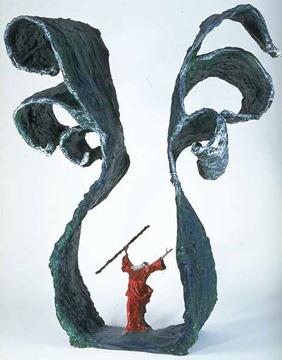
The sculpture consists of two elements that are not meant to depict the event in a realistic way, but to express the focus and emotion in this decisive chapter. Wearing red garments that emphasize his role and importance, a bearded Moses raises his staff to the heavens and also stretches out his hand. This motion can be understood as representing the moment when he split the sea at the command of God; Moses is the one who performs the miracle, but he also acts exclusively as an emissary on behalf of God.
Moses stands at the bottom of giant u-shaped form that symbolizes the sea. Moses’ small dimensions in comparison to the sea reflect both the enormity of his task and his role as God’s chosen messenger.
The shape of the water is also reminiscent of a bottle with a narrow neck. The image is one of birth – Moses, as the representative of the Children of Israel, is about to be born. Katrina Krauss, a Christian nun who has worked for many years with an African tribe and illustrated the Bible using their style, created another painting based on the same image.
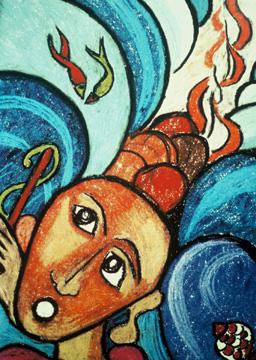
Katrina Krauss, The Splitting of the Red Sea, c. 1980
In both these works, as opposed to the works by James and Field, Moses, who is identified by his staff, assumes a central place. Another image focusing on Moses is a woodcut by Jacob Steinhardt.

Two foci draw the viewers’ attention: the light breaking through on the top left and Moses’ face. In the biblical description, the Children of Israel walked through the seabed throughout the night and emerged from it at dawn. Light often also symbolizes hope for the future. But the look on Moses’ face seems to express fear or even terror; perhaps at the sight of the drowning of the Egyptian or perhaps regarding the difficult journey that still lies ahead for the Children of Israel.
Pharaoh's fate
In the painting below, we encounter the Muslim world in an interpretation by an anonymous 18th century Persian artist.
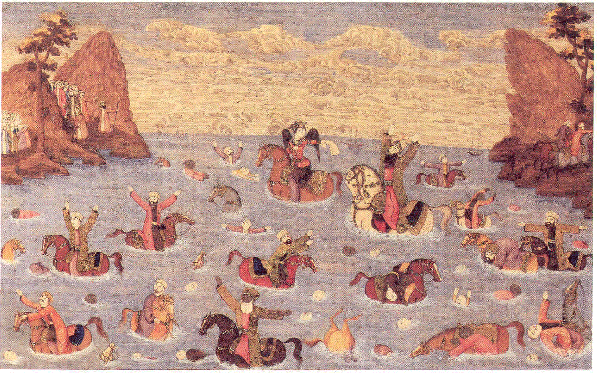
Persia, 18th century
Two figures stand out among the Egyptians drowning in the sea. According to the Quran (10: 90 - 92), the angel Gabriel was sent to Pharaoh in order to deliver in writing his divinely decreed fate. In response, Pharaoh finally acknowledged the power of God. Commentators on the Koran disagree over the outcome: Some say that Pharaoh was saved because of his repentance; others claims that his repentance under duress was not deemed acceptable and therefore he also drowned.
Some Jewish Midrashim claim that Pharaoh was indeed saved as a result of his confession, and miraculously, was sent to Nineveh, where he ruled for 400 years until the time of Jonah the prophet. It was he that encouraged the Ninevites to repent.
Another painting featuring the Egyptians and Pharaoh appears in the Sarajevo Haggadah.
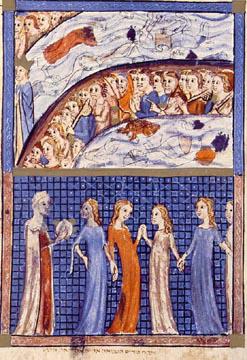
On this page from the haggadah, there are two pictures relating to the splitting of the Red Sea. Above, the Children of Israel are still crossing the sea along several different paths, while the Egyptians have already drowned… except for Pharaoh, who appears on the left side. It appears that here, too, Pharaoh was saved.
Below, Miriam leads the chorus of the women of Israel in the Song of the Sea. They do not look tired at all from their journey through the Red Sea, but rather they appear to be courtly women who are dancing at a festive celebration. Comparison with the women’s chorus in the Laura James painting illustrates how differently each artist imagines the past based on his/her own present.
In our Persian painting as well, the Israelite women appear on the seashore. But in this case, they are standing at the very edge of the painting and distinctly separate from the men. Once again it is evident that the portrayal of the past is based on the conventions of the present.
The Splitting of the Sea at Dura Europos
Up to now, we have considered relatively modern works of art. Let us now consider a drawing that is over 1,700 years old.

Dura Europos, The Splitting of the Red Sea, 244
In the wall paintings in the Dura Europos synagogue, dating from 244 CE, Moses appears many times. In this one painting alone he appears three times: on the right, he raises his staff in order to split the sea; in the center he is restoring the sea to its place and drowning the Egyptians; and on the left, he stands beside the “armed” Children of Israel (Exodus 13:18) as they sing the Song of the Sea. One explanation for these multiple depictions is that in this way the artist tried to illustrate the passage of time in the story of the splitting of the sea. Another possibility is that it is meant to emphasize the importance of Moses, as the ideal leader of the People of Israel and the hope for the future. But a third possibility is that this painting is a composite based on three separate lost models.
Note that behind the double of Moses on the left side, there are horizontal stripes (paths). Similar stripes appear in the painting from the Sarajevo Haggadah. Midrash Tanhuma explains the meaning of these paths: a separate path in the water was made for each of the tribes, further marking the greatness of the miracle. Another Midrash explains the two hands of God, as a visual expression of the repetition of the word “right” in Exodus 15:6:
Your right hand, O Lord, glorious in power,
Your right hand, O Lord, shatters the foe!
This Midrash further explains that each use of the word has a different function: one hand is saving the People of Israel and one hand is drowning the Egyptians. Therefore, as in many of our paintings, there is a reflection of the tension between the joy over the liberation and the sadness of over the loss of life.



